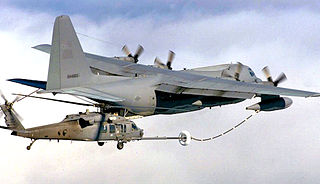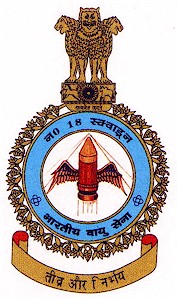
The Indian Air Force (IAF) is the air arm of the Indian Armed Forces. Its primary mission is to secure Indian airspace and to conduct aerial warfare during armed conflicts. It was officially established on 8 October 1932 as an auxiliary air force of the British Empire which honoured India's aviation service during World War II with the prefix Royal. After India gained independence from United Kingdom in 1947, the name Royal Indian Air Force was kept and served in the name of the Dominion of India. With the transition to a republic in 1950, the prefix Royal was removed.

Indian Peace Keeping Force (IPKF) was the Indian military contingent performing a peacekeeping operation in Sri Lanka between 1987 and 1990. It was formed under the mandate of the 1987 Indo-Sri Lankan Accord that aimed to end the Sri Lankan Civil War between Sri Lankan Tamil militant groups such as the Liberation Tigers of Tamil Eelam (LTTE) and the Sri Lankan military.
The Eastern Air Command is one of the five operational commands of the Indian Air Force. Currently headquartered in Shillong in Meghalaya. Named No. 1 Operational Group at the time of its inception, 27 May 1958, it was based at Ranikutir in Kolkata as a part of the Govt's increasing emphasis on defence of the eastern borders. The Operational Group was upgraded as Command on 1 December 1959 with headquarters at Fort William, Kolkata and Air Vice Marshal KL Sondhi as the first AOC-in-C of the Eastern Command. After the 1962 Indo-Chinese War, The decision was made to raise a full-fledged command at Shillong. The area of responsibility of the command now covers 11 states, and is bound by the international boundaries of Nepal, Bhutan, China, Myanmar and Bangladesh incorporating 6300 km of common border. Eastern Air Command now has permanent airbases at Chabua, Guwahati, Bagdogra, Barrackpore, Hasimara, Jorhat, Kalaikunda and Tezpur with forward airbases at Agartala, Kolkata, Panagarh and Shillong. Eastern Air Command consists of Air Defence squadrons consisting of the MiG-21 and Ground attack squadrons consisting of the MiG-27. It holds the motto "Samareshu Parakramaha",

Operation Poomalai, also known as Eagle Mission 4, was the codename assigned to a mission undertaken by the Indian Air Force for airdropping supplies over the besieged town of Jaffna in Sri Lanka on 4 June 1987 to support the Tamil Tigers during the Sri Lankan Civil War.
The Jaffna University Helidrop was the first of the operations launched by the Indian Peace Keeping Forces (IPKF) aimed at disarming the Liberation Tigers of Tamil Eelam (LTTE) by force and capturing the town of Jaffna, Sri Lanka, in the opening stages of Operation Pawan during the active Indian mediation in the Sri Lankan Civil War. Mounted on the midnight of 12 October 1987, the operation was planned as a fast heliborne assault involving Mi-8's of the No.109 HU, the 10th Para Commandos and a contingent of the 13th Sikh LI. The aim of the operation was to capture the LTTE leadership at Jaffna University building which served as the Tactical Headquarters of the LTTE, which was expected to shorten Operation Pawan, the battle for Jaffna. However, the operation ended disastrously, failing to capture its objectives due to intelligence and planning failures. The helidropped force suffered significant casualties, with nearly the entire Sikh LI detachment of twenty-nine troops, along with six paracommandos, falling in battle.

The New York Air National Guard (NY ANG) is the aerial militia of the State of New York, United States of America. It is, along with the New York Army National Guard, an element of the New York National Guard.
Operation Pawan was the code name assigned to the operation by the Indian Peace Keeping Force (IPKF) to take control of Jaffna from the Liberation Tigers of Tamil Eelam (LTTE), better known as the Tamil Tigers, in late 1987 to enforce the disarmament of the LTTE as a part of the Indo-Sri Lanka Accord. In brutal fighting lasting about three weeks, the IPKF took control of the Jaffna Peninsula from the LTTE, something that the Sri Lankan Army had tried but failed to do. Supported by Indian Army tanks, helicopter gunships and heavy artillery, the IPKF routed the LTTE at the cost of 214 soldiers and officers.Many Indian soldiers died
The Indian Air Force was established on 8 October 1932 independently of the army and navy and in a similar format to the British Royal Air Force. It had been a recommendation of the Skeen Committee, which had been tasked to look into demands for the Indianisation of the Indian army. Its first squadron was raised on 1 April 1933.
INS Rajali, is an Indian naval air station located near Arakkonam, Ranipet district, Tamil Nadu in southern India. It operates under the Southern Naval Command of the Indian Navy, and has the longest military runway in Asia.
Operation Liberation also known as the Vadamarachchi Operation was the military offensive carried out by the Sri Lankan Armed Forces in May and June 1987 to recapture the territory of Vadamarachchi in the Jaffna peninsula from the LTTE. At the time it was the largest combined services operation undertaken by the armed forces deploying multiple brigade size formation, becoming the first conventional warfare engagement on Sri Lankan soil after the end of British colonial rule. The operation involved nearly 4,000 troops, supported by ground-attack aircraft, helicopter gunships and naval gun boats. The offensive achieved its primary objective, however operations were suspended when the Indian government dropped food supplies over Jaffna in Operation Poomalai on June 4, 1987, which prompted the Sri Lankan government to accept the Indo-Sri Lankan Accord.
The Western Air Command (WAC) is the regional command of Indian Air Force headquartered in New Delhi. It is the largest and most important Air Command of the IAF, comprising sixteen Air Force Bases (AFBs), and is responsible for aerial defence of North India.
The Indian intervention in the Sri Lankan Civil War was the deployment of the Indian Peace Keeping Force in Sri Lanka intended to perform a peacekeeping role. The deployment followed the Indo-Sri Lankan Accord between India and Sri Lanka of 1987 which was intended to end the Sri Lankan Civil War between militant Sri Lankan Tamil nationalists, principally the Liberation Tigers of Tamil Eelam (LTTE), and the Sri Lankan military.
Sulur Air Force Station is an air base of the Indian Air Force located at Sulur near Coimbatore, Tamil Nadu and is India's second largest air base after Hindon AFS. It is the base which is responsible for protection of India's sea area. It is the only base in India which handles both fighter and transport flights at one location; no other base in India is equipped to do so. It is also the only IAF base in India to have all Departments at one location: fighters, carrier planes, carrier helicopters, attack helicopters, a repair and overhauling depot, TETTRA school, Garud Force, Air Force Hospital, Southern Command Sub Headquarters, & ECHS. It is a former Royal Navy and Indian Navy base.

No. 18 Squadron, is an air-defence unit of the Indian Air Force, flying from Sulur Air Force Station. The squadron is equipped with indigenous HAL Tejas MK1 in FOC configuration.

Operation Surya Hope was the Indian Army’s Central Command response to the June 2013 North India floods in Uttarakhand. The Uttarakhand flood was caused by record off-season monsoon rains, cloud burst, floods, flash floods, and glacial lake outburst floods (GLOFs), which were possibly induced by climate change. The humanitarian disaster affected millions, stranded over 100,000 pilgrims and tourists in Himalayan religious sites, and killed several thousand people. The Indian Army's Lucknow based Central Command conducted the operation. Surya or Sun, is the emblem of the Central Command and features prominently on the Command's formation sign and flag, which is probably why Central Command chose to name the effort Operation Surya Hope.

In the wake of heavy monsoon rain and flash floods in Jammu and Kashmir, the Indian Armed Forces were deployed in increasing numbers starting 2 September 2014 to conduct search, rescue, relief, relocation, humanitarian assistance and rehabilitation missions in Jammu and Kashmir. By 18 September, over 298,514 people were rescued from the various parts of Jammu and Kashmir by the Armed forces. The Jammu and Kashmir floods, the worst in a century according to Omar Abdullah, the Chief Minister of Jammu and Kashmir, paralyzed the state government. Omar Abdullah, responding to public criticism, told the media "I had no government" in the first few days following the floods, as "My secretariat, the police headquarters, the control room, fire services, hospitals, all the infrastructure was underwater." Adding "I had no cell phone and no connectivity. I am now starting to track down ministers and officers." The Jammu and Kashmir floods of 2014 have been blamed on heavy rainfall, about 8 inches (200mm) on 4 September alone, on climate change, unplanned and uncontrolled development, encroachment of river banks, lakes, ponds, and massive loss of wet lands, absence of local government flood forecasting system, and poor governance. The Armed Forces humanitarian assistance mission in response to the floods was named Mission Sahayata (assistances). Northern Command's humanitarian assistance to Civil authorities was named 'Operation Megh Rahat'. The Indian Army, Air Force, and the Navy, committed large resources to the assistance mission including over 30,000 troops, 15 engineer task forces, 84 Indian Air Force and Army Aviation Corps fixed wing transport aircraft and helicopters, naval commandos and rescue specialists, and Base Hospital, four field hospitals, over 106 medical detachments. "Operation Megh Rahat", ended on 19 September 2014, but "Operation Sadbhavna", the relief and medical assistance support, according to government press release, will continue in "close synergy with the civil administration and the police".

No. 44 Squadron is a unit of the Indian Air Force assigned to Maintenance Command. The Squadron participates in operations involving air, land and air-drop of troops, equipment, supplies, and support or augment special operations forces, when appropriate.

No. 43 Squadron is a unit of the Indian Air Force assigned to Eastern Air Command. The squadron participates in operations involving air, land and airdrop of troops, equipment, supplies, and support or augment special operations forces, when appropriate.

No. 125 Helicopter Squadron (Gladiators) is a fighter squadron and is equipped with Apache AH-64E and based at Pathankot Air Force Station.
No. 155 Helicopter Unit is a helicopter unit equipped with Mil Mi-17V5. It is based at Suratgarh Air Force Station.









